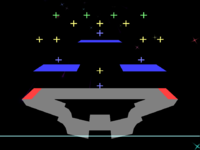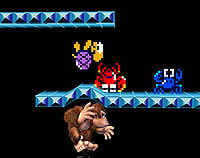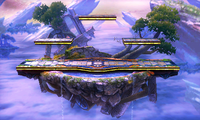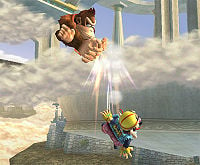Platform

Platforms are stage features that make up the floor upon which characters may stand and objects may land. The main difference between a platform and a standard floor is that a platform is mostly disconnected from other parts of a stage and usually hover in place like floating islands. There are four distinct types of platforms: hard, semisoft, soft, and supersoft, each of which differs in its tolerance of the vertical movement of characters and objects through it. Platforms sometimes accommodate ledges from which characters can hang, and may also incorporate slopes, movement, hazards, and destructible and interactive features. Some bosses are also platforms, and characters can stand upon them. The appearance of platforms ranges from simple or abstract polygonal solids and flat planks, to recognisable objects such as buildings, ships and creatures. Items can land upon platforms, and some, such as the Hothead and Motion-Sensor Bomb, interact with them. Most versus stages involve a large, central, hard or semisoft platform with ledges that may be grabbed, and additional, smaller platforms elsewhere. Stage Builder in Super Smash Bros. Brawl offers a variety of platforms, some unlockable, that can be arranged and customized by players, and Super Smash Bros. for Wii U allows players to draw platforms of different shapes with the Wii U's GamePad. Super Smash Bros. Ultimate also gained the ability to create and draw platforms in Stage Builder that was added in version 3.0.0.
Platform types[edit]
Hard platforms[edit]
Hard platforms are solid and cannot be passed through in any direction—their sides are walls, their undersides are ceilings and they usually have ledges that can be hung onto. Hard platforms often form the main bodies of versus stages, such as Hyrule Castle, Pokémon Stadium, and Luigi's Mansion.
Semisoft platforms[edit]
Semisoft platforms are platforms that characters can travel upwards through, but not downward. They do not have walls or ceilings; characters who approach from below or from the side will go through them. Semisoft platforms are sometimes used in versus stages as main platforms, and may or may not possess ledges. Kongo Falls, which has ledges, and Port Town Aero Dive, which does not, are two examples. Many conventional 2D platform games, such as those of the Kirby and Mario series, include this kind of platform frequently. Spring Stadium has "reverse" semisoft platforms in the form of arches above the stage; characters can travel through them downwards, but not upwards.
Soft platforms[edit]
Soft platforms, also known as pass-through or fall-through platforms, are thin platforms that characters, projectiles, and items can pass through upwards, and that characters may also pass through downwards. Most soft platforms do not have ledges that characters may hang from, although there are exceptions, such as the upper platforms of Norfair. While standing on a soft platform, a character may fall down through it by tapping down on the control stick. Shield platform dropping is a technique which can aid in attaining the standing state necessary to drop through soft platforms. Airborne characters may pass through a soft platform from above by holding down on the control stick as they approach it, though in SSB this can only be done when the character is helpless.
All airborne items and projectiles, including Pikachu's Thunder, will travel upward through soft platforms, but will not travel downward through them. The same is true of tumbling and reeling characters, who will fly upward through soft platforms, but will land in a lying position upon a soft platform if they contact it from above. When used under a soft platform, certain special moves, such as Ike's Aether and Bowser's grounded Bowser Bomb, may send their performers upward through the platform during the rising portion of the move, and then downward onto the platform during the falling portion. This is also the case with Kirby and Meta Knight's up throws; both the grabber and the victim will rise through soft platforms, but "crash land" onto them during the falling part of the move.
Characters performing aerial attacks, including stall-then-fall maneuvers, cannot fall through soft platforms during the attack. Most special moves also follow this rule, with exceptions such as Yoshi's Yoshi Bomb (while down is held or within a certain timing window of starting the move) in Super Smash Bros. Ultimate and the up special moves of Fox, Falco, and Wolf when used in the air, which will pass down through soft platforms when directed at a downward angle.
Supersoft platforms[edit]
Supersoft platforms were introduced in Super Smash Bros. Brawl and appear on the stage Skyworld, where they take the form of floating clouds. These cloud platforms have the same fall-through properties as soft platforms, but are distinct in that airborne characters who have been hit from above can fly downward through them. This can happen either when an airborne character is meteor smashed, or a character is hit upward and rebounds down from the ceiling of a higher hard platform. However, characters who are attacked by downward thrusting attacks will not be pushed down through cloud platforms if they are standing on them. Skyworld's cloud platforms do not have ledges, but the stone platforms that usually cover them do.
In Super Smash Bros. for Nintendo 3DS and Super Smash Bros. Ultimate, Magicant's cloud platforms are supersoft, but unlike Skyworld's, they do not allow players to naturally pass down through them and they have grabbable ledges.
Platform features[edit]
There are a variety of extra features that platforms may possess in addition to their basic properties.
- Ledges – Some hard, semisoft and soft platforms have ledges that characters can grab or, in Brawl, SSB4 or Ultimate, tether to. Ledges are most frequently found on hard platforms.
- Terrain types – All platforms and floors have a type of terrain assigned to them. Examples include normal, metallic, and grassy.
- Uneven ground – Some platforms are angled, or incorporate sloped or curved terrain, such as that of Green Hill Zone.
- Walls – Present only on hard platforms, walls typically constitute the sides of large islands, and are distinct in that characters may perform wall jumps and other techniques with them.
- Vertical/lateral movement – Some platforms, such as the small platforms in Kongo Jungle (SSB), travel up and down or from left to right along a set path, while others, such as the pulley platforms in Mushroom Kingdom, and leaf platforms in Distant Planet will move up and down in response to the weight of the characters standing upon them. Some platforms that move along set paths, such as the Arwings in Corneria, cross blast lines during their routines.
- Tilting and rotation – Certain platforms, such as the magma cavern of Castle Siege, tilt continuously and result in surfaces with slopes that are constantly changing. Other platforms, like that of Brinstar Depths and the Helirin Assist Trophy, perform complete rotations, transitioning from platforms into walls and back again as their angles change.
- Special surfaces – Platforms with special surfaces affect players' movement when they interact with them. Slippery platforms, like those found in Summit, prolong characters' ground momentum and cause them to slide along the ground. Rolling surfaces, like those found in the electric phase of Pokémon Stadium 2 and on the slope of Distant Planet in the rainy weather, cause players to move in one direction along the ground while they stand, walk, run or attack. Bouncy platforms and springs, like those found in a transformation of PictoChat, are not possible to walk upon because they propel characters high upward upon contact.
- Destructibility – Particular platforms are possible to destroy or alter after they, or adjacent stage structures, take enough damage. They regenerate after a set period of time has passed. For example, the yellow platforms in Skyworld break and disappear after they are struck by enough attacks, the main platform of Brinstar splits in two after the organic material in its centre is destroyed by hits, and the floor platforms of Luigi's Mansion are destroyed as its pillars are broken by damage. Onett's awning platforms are not affected by attacks, but will collapse and disappear after enough characters jump onto them.

- Switch activation – Some platforms, such as the coloured ones in Princess Peach's Castle, do not appear until prompted by the activation of switches.
- Falling away – Certain platforms, such as Drop Blocks and the Donut Lift platforms of Rainbow Cruise, drop downward and eventually disappear when stood on for long enough, and regenerate after a certain amount of time.
- Bump ceilings – The Mario Bros. stage has blue hard platforms that can be bumped. When a knocked or jumping character or item hits the ceiling of one of these blue platforms, that part of the platform raises slightly in response. When positioned on a platform, the stage's native enemies will jump or flip upside down if the platform's ceiling is bumped from below. Characters who are bumped from below will jump.
Platforms and items[edit]
All items can land on platforms, but some interact with them in more elaborate ways.
- Barrels and Rolling Crates will roll faster when on sloped platforms. Rolling Crates also serve as platforms, since characters can stand on them.
- A character using a Golden Hammer can walk off a platform and stay level with it while airborne.
- Freezies slide along the surface of platforms on appearance, and Red and Green Shells slide along platforms when thrown.
- If left idle, Bob-ombs and Mr. Saturns will walk along platforms and turn at edges.
- Motion-Sensor Bombs and Gooey Bombs adhere to platform surfaces when thrown, including walls and ceilings.
- Hotheads and Bombchus slide and cling to surfaces, and will circumnavigate most hard and semisoft platforms if thrown onto them. They can slide along soft platforms, but will fall from their edges because they cannot cling to their undersides.
- When used, Warp Stars will rise through platforms, but will not fall down through them.
- The Helirin Assist Trophy is a floating hard platform that rotates.
- The Poké Ball Pokémon Gogoat serves as a platform.
- In relation to platforms, the behaviour of Smash Balls varies; sometimes they pass through solid surfaces, other times they bounce from them.
- The Landmaster and Iceberg Final Smashes create platforms. Landmasters can be stood upon by players—one particular technique involves raising the Landmaster off the top of the screen in order to Star KO characters standing upon it. While the slopes of the Iceberg cannot be stood upon, characters may stand upon its tip in their teetering animation.
- The bosses Porky and Duon, as well as the standard enemies Trowlon, Gamyga, and Armank, serve as platforms.

